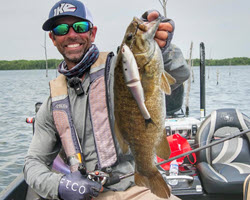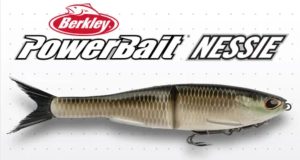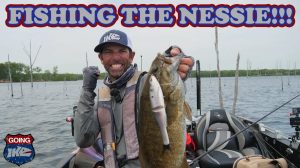
The Berkley Nessie is an incredible bait not just because it fills a void by essentially crating the category of soft glide baits, but also because you can fish it so many different ways. Whether you’re an absolute novice or you’ve been fishing with glide baits for years, I encourage you to experiment with it. You may find new ways that work best on your home waters, but when starting out you’ll want to focus on six basic retrieves.

The first is the simplest – just a steady retrieve. All you have to do is make a long cast and when it hits the water start reeling at a moderate place. The bait does all of the work. Every once in a while, make a slight pause and throw some slack into it. The lure will turn 180 degrees and that’s often when the strike will occur.
The second retrieve I like to employ is the slow roll. I often stick nail weights into the pre-marked circles for this one, depending on how deep I want the lure to run. It’s much like the steady retrieve, but as the name suggests much slower. Again, make a long cast, let it sink to the desired depth, and then crawl it back at a snail’s pace. Mix in a pause now and again and it’ll fade off.

My next favorite is exactly the opposite of the slow roll. I burn it back to the boat! This is often best in clear water, when I’m trying to generate a reaction strike. A lot of the hard glide baits will burn out on this retrieve. They can’t handle the speed, but the Nessie can. It kicks and swims at any speed.
My fourth retrieve is a variation of the burning pace. I refer to it as “waking.” You’re still reeling fast, but keeping your rod tip high so it’s almost like a topwater presentation. It’ll snake across the surface in an ultra-natural manner and the strikes can be vicious.

If you’ve ever fished a suspending jerkbait, then you know how to “walk” the bait, and the Nessie excels when you jerk it, too. It’s all about the cadence, dialing in the number of twitches and pauses. Change it up now and again to keep them honest, and let the fish tell you what they want.
Finally, my sixth retrieve is what I call the “dead walk.” It’s the same cadence as walking it on top, but just under the surface. With this retrieve you can keep it in the strike zone forever. Twitch, reel, twitch, reel, twitch, reel. The lure has a distinctive left-to-right movement that they can’t resist.
With all of these retrieves, those pauses are the key. They’re often the trigger for the bite. When that Nessie does a 180 and the fish comes face-to-face with those big eyes and natural paint jobs, more often than not they react out of anger or fear or hunger.
Remember the price on these is insane for a bait of this quality – under $15 for all of the different sizes and color combinations. Perhaps just as importantly, you don’t need specialized tackle to fish them. I throw the 9-incher on a 7’3” to 7’6” medium heavy baitcasting rod. I throw the 7-incher on a 7’ to 7’4” medium heavy. The 5-incher works well with either casting or spinning gear, so choose the outfit that works best for you. No matter what gear you’re using, I cannot emphasize enough how many different ways you can make this lure look like an easy meal. I can’t wait to figure out even more and report back.
_________________________________________________
